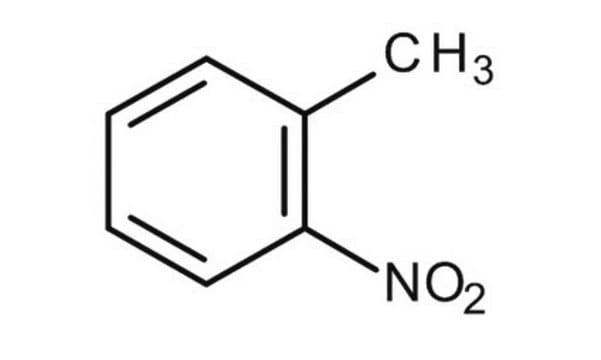所有图片(1)
About This Item
线性分子式:
CH3C6H4NO2
CAS号:
分子量:
137.14
Beilstein:
1907580
MDL號碼:
分類程式碼代碼:
12352102
PubChem物質ID:
推荐产品
化驗
≥99%
折射率
n20/D 1.546 (lit.)
bp
225 °C (lit.)
mp
−4-−3 °C (lit.)
密度
1.163 g/mL at 25 °C (lit.)
SMILES 字串
Cc1ccccc1[N+]([O-])=O
InChI
1S/C7H7NO2/c1-6-4-2-3-5-7(6)8(9)10/h2-5H,1H3
InChI 密鑰
PLAZTCDQAHEYBI-UHFFFAOYSA-N
正在寻找类似产品? 访问 产品对比指南
法律資訊
DuPont 产品
取代透過
产品编号
说明
价格
Sikandar I Mulla et al.
Biodegradation, 22(1), 95-102 (2010-06-29)
A bacterial consortium capable of degrading nitroaromatic compounds was isolated from pesticide-contaminated soil samples by selective enrichment on 2-nitrotoluene as a sole source of carbon and energy. The three different bacterial isolates obtained from bacterial consortium were identified as Bacillus
Homeira Ebrahimzadeh et al.
Talanta, 79(5), 1472-1477 (2009-07-29)
Dispersive liquid-liquid microextraction (DLLME) coupled with gas chromatography-flame ionization detector (GC-FID) was developed for preconcentration and determination of some nitroaromatic compounds in wastewater samples. The effects of different variables on the extraction efficiency were studied simultaneously using experimental design. The
Ismael Cotte-Rodríguez et al.
The Analyst, 130(5), 679-686 (2005-04-27)
The use of two methods in tandem, single-sided membrane introduction mass spectrometry (SS-MIMS) and fiber introduction mass spectrometry (FIMS), is presented as a technique for field analysis. The combined SS-MIMS-FIMS technique was employed in both a modified commercial mass spectrometer
Sikandar I Mulla et al.
Chemosphere, 90(6), 1920-1924 (2012-11-17)
Nitrotoluenes are the toxic pollutants of the environment because of their large scale use in the production of explosives. Biodegradation of such chemicals by microorganisms may provide an effective method for their detoxification. We have studied the degradation of 2-nitrotoluene
Akané E Hartenbach et al.
Environmental science & technology, 42(22), 8352-8359 (2008-12-17)
Compound-specific nitrogen isotope analysis was shown to be a promising tool for the quantitative assessment of abiotic reduction of nitroaromatic contaminants (NACs) under anoxic conditions. To assess the magnitude and variability of 15N fractionation for reactions with dissolved reductants, we
我们的科学家团队拥有各种研究领域经验,包括生命科学、材料科学、化学合成、色谱、分析及许多其他领域.
联系技术服务部门








